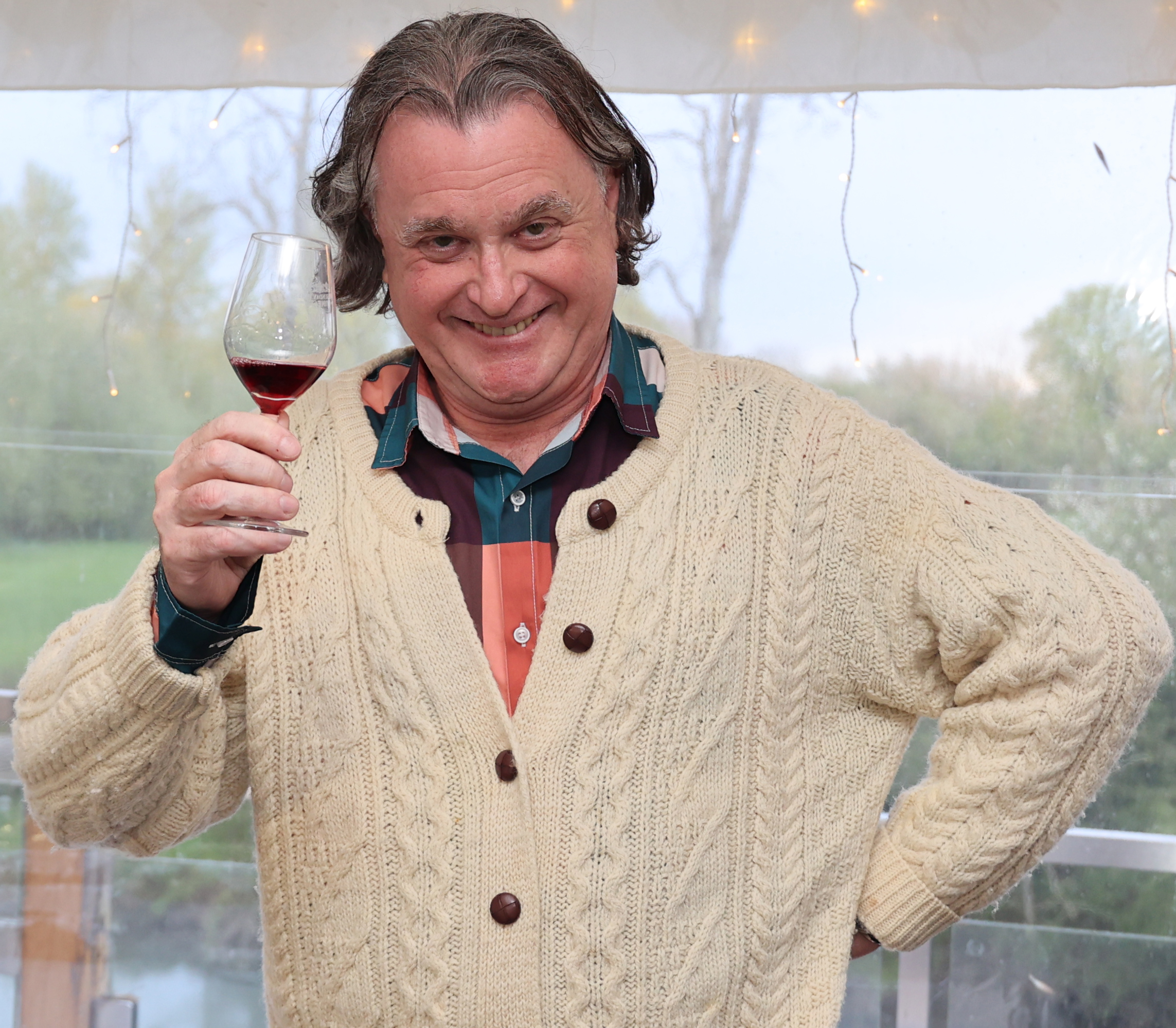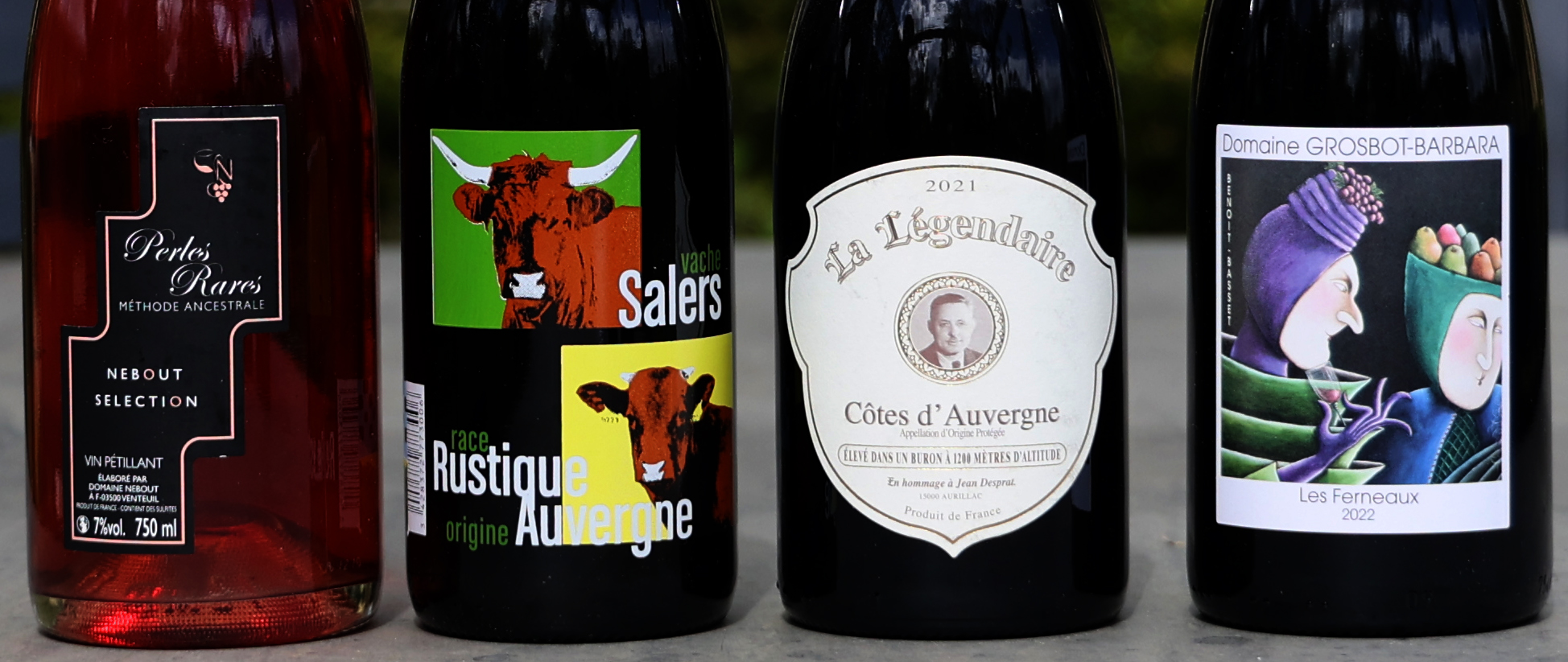 Currently Sommelier and Bar Manager at St John’s College, Oxford, Yannick Joseph has had a long and stellar career in both catering and the world of wine. An award-winning chef, expert in champagnes, born in the Auvergne and also expert on the wines of the Loire and Rhône as well as the Auvergne, Yannick brought a unique, refreshingly different and very personal approach to this tasting.
Currently Sommelier and Bar Manager at St John’s College, Oxford, Yannick Joseph has had a long and stellar career in both catering and the world of wine. An award-winning chef, expert in champagnes, born in the Auvergne and also expert on the wines of the Loire and Rhône as well as the Auvergne, Yannick brought a unique, refreshingly different and very personal approach to this tasting.
Introducing us to the area, which is mid-way between Lyon and Limoges and is located in the Puy de Dôme département, Yannick told us there are more cows than people in the Auvergne, with around 1.75 cows per person. The Auvergne is perhaps better known in the UK for its cheeses (Saint Nectaire, Cantal, Salers, Fourme d'Ambert and Bleu d'Auvergne) than wines. The Auvergne (technically part of the Loire Valley) is also home to the production of mineral waters such as Vichy and Volvic, due to the unique qualities of the volcanic soil.
Few of the wines produced in the Côtes d’Auvergne AOC are currently exported or well-known even in France. However, the Auvergne was one of the most important wine growing regions of France in the 19th century, pre-phylloxera. The most widely grown grape variety in the Auvergne AOC is Gamay (c 300 hectares), with some Pinot Noir and Chardonnay plus a few local grape varieties. There are five commune names that may be appended to the Côtes d’Auvergne AOC – Boudes, Chanturgue, Châteaugay and Madargue for reds and Corent for rosés.
In the Saint-Pourçain AOC, which has been an AOC since 2009, white, rosé and red wines are produced on vineyards covering 600 hectares (1,500 acres) in 19 communes of the Auvergne region around Saint-Pourçain-sur-Sioule. For whites, the main grapes are Chardonnay and Sacy, known locally as Tressallier. For red wines, Gamay and Pinot noir are used. For rosé wines, only Gamay is used.
Not generally available in the UK, Yapp Bros however list one or two Saint-Pourçain wines.
Commenting on the sequence of the wines served during the tasting, Yannick reminded us that the acidity of the whites helps prise the tannins from your mouth, and leaves you refreshed and ready for more!
The Club owes a debt of gratitude to Yannick – and his brother – for specially importing the wines for this tasting.
We also owe Yannick a debt of gratitude for his exemplary introduction to the cuisine of the Auvergne, including the Brioche aux grattons (pork scratchings) and Truffade, a local dish made with potatoes (trufada is the Auvergne word for potato) and which includes Cantal or Tomme cheese and some lardons. His presentation was scattered with culinary hints – ‘Pinot noir and pork don’t go together’ and ‘serve cheese with white wine not red!’ Yannick also gave us an introduction to the Auvergne from a vino-tourist perspective, including the Museum of Vine & Terroir near Saint-Pourçain and the beautiful city of Vichy. An OWC trip there sometime?
Wine 1 – Perles Rares NV 8% (according to website (Gamay) Domaine Nebout
From the area around Alliers, this sparkling wine is made using the méthode ancestrale with a single fermentation, which is stopped by cooling the vat. The wine is then bottled and left until the following spring, when natural fermentation occurs (like ‘pet nat’). The grapes are grown organically on primarily clay/limestone, sand and gravel soils. On the nose and palate, lots of red fruits. Made by the fifth generation of wine makers from the same family. Circa 9€ sold locally.
stopped by cooling the vat. The wine is then bottled and left until the following spring, when natural fermentation occurs (like ‘pet nat’). The grapes are grown organically on primarily clay/limestone, sand and gravel soils. On the nose and palate, lots of red fruits. Made by the fifth generation of wine makers from the same family. Circa 9€ sold locally.
Wine 2 – Collection Salers NV 12.5% (Gamay noir) Domaine Desprat Saint Verny ‘IGP Puy de Dôme’
Made by another fifth generation of wine makers, the Desprat Saint Verny vineyard covers 180 ha of vines on the Chaîne des Puys, which is listed as a UNESCO World Heritage Site. The wines have good minerality and freshness, with the vines grown on terroirs of ashes, lava or basaltic deposits.
This wine, although described as Gamay, has an undisclosed percentage of Pinot noir in the blend. Fermented in stainless steel, with flavours of blackcurrant and a touch of smoke on the nose. About 9.95€ sold locally. Serve cool for maximum effect.
The wine listed as 4 on the tasting sheet was served next, so a comparison could be made with Wine 2.
Wine 4 – Les Ferneaux 2022 13% (Gamay) Domaine Grosbot-Barbara AOC Saint-Pourçain
From a 2.90 ha vineyard of the same name, located in Bransat, on granite soil. After blending, this wine is predominantly Gamay although no cepage is declared. Some spice on the palate, as a result of a little unspecified ageing in barrels from the nearby Tronçais forest. Capable of ageing for 1-2 years. Richer and with more length and depth than Wine 2 above. Due to the Gamay both wines were hightly reminiscent of a well-made Beaujolais.
Denis Barbara, the wine maker, studied viti-oenology in Burgundy, and formed the Grosbot-Barbara estate along with Eli Grosbot in 1996. He is considered one of the best wine makers in the area.
Wines 3 and 5 were served next so that once again a comparison could be made.
Wine 3 – La Légendaire 2021 13% (60% Gamay, 40% Pinot noir according to their website) Domaine Desprat Saint Vernay ‘AOP Côtes d’Auvergne’
Made with grapes from old vines. Matured for 12 months in oak barrels, then aged for 6 months in an old farmhouse at an altitude of 1200 metres. A slightly floral nose, some cherries and chocolate on the palate, good length. Will keep for 4-8 years. A good match for grilled steak or cheese. 15,50€ direct from the vineyard.
 Wine 5 – Les Maltôtes 2022 14.5% (30% Gamay 70% Pinot noir) Domaine Grosbot Barbara AOC Saint-Pourçain
Wine 5 – Les Maltôtes 2022 14.5% (30% Gamay 70% Pinot noir) Domaine Grosbot Barbara AOC Saint-Pourçain
From a 1.14 ha vineyard, located in Montord on clay-limestone soil. Composed of Pinot noir blended with Gamay with Pinot noir dominating. The wine was vinified and aged in barrels, with no fining or filtration. On the nose and palate powerful black fruit notes. Has ageing potential.
Wine 6 – Privilège 2022 13.5% (Chardonnay) Domaine Desprat Saint Verny AOP Côtes d’Auvergne
Grown on old vines on clay/limestone soil. Aged for 10 months in oak barrels. Some stone fruits on the nose and palate, some spices, could be kept for 2-6 years. 15,20€ direct from the vineyard. As Yannick said, if you’re in the area try it with Blanquette de Veau.
Wine 7 – SAS Prince Charles-Henri de Lobkowicz 13% (70% Chardonnay, 30% Tressallier) AOC Saint Pourçain
Made by Grosbot-Barbara. This wine is sponsored by a member of the Bourbon family who lives in the Bourbonnais. (The ‘SAS’ stands for ‘Son Altesse Sérénissime’.) The wine is vinified in barrels, with a minimum aging of 15 months. Tressallier (Sacy) is an early budding grape that is vigorous and fertile – similar to Aligoté and Melon de Bourgogne. High in acidity and low in alcohol. It is possible to add up to 10% of undeclared Sauvignon Blanc under the Saint-Pourçain appellation.
Wine 8 – Les Maltôtes 2022 13.5% (50% Chardonnay, 50% Tressallier) Domaine Grosbot-Barbara AOC Saint Pourçain
From a 1.02 hectare vineyard of the same name, located in Montord with clay-limestone soil, this wine is vinified in barrels, with a minimum aging of 15 months.
Considered to be a more balanced wine by those present, good stone fruits and good acidity and length. Definitely a good food wine. Denis Barbara’s philosophy is to take the best wines of other producers and then produce his own take – at 2€ a bottle more! This wine would probably retail around 24€.
HRE 23.4.24